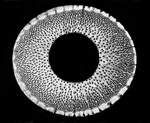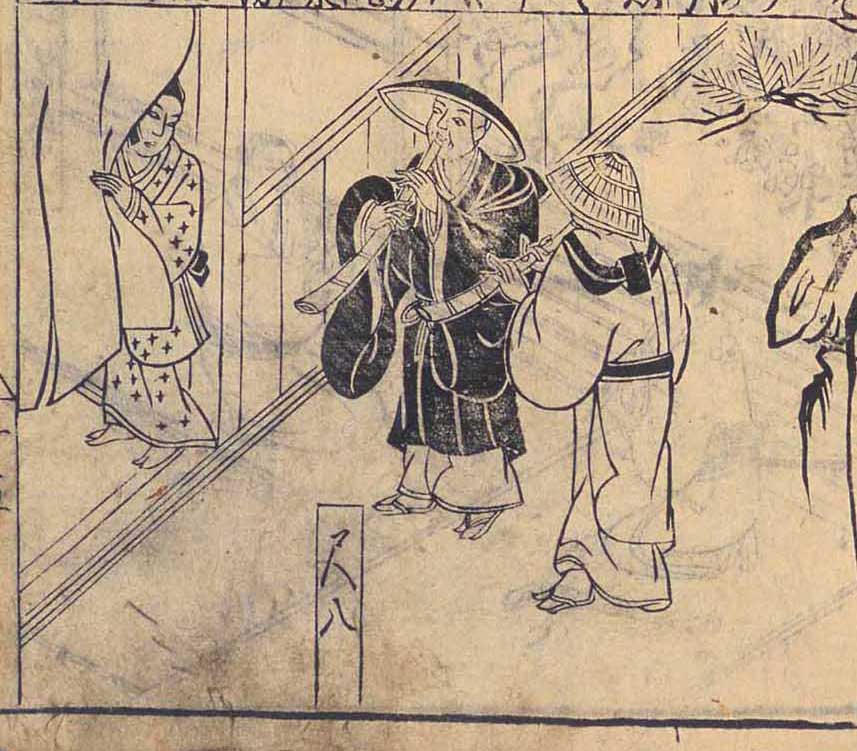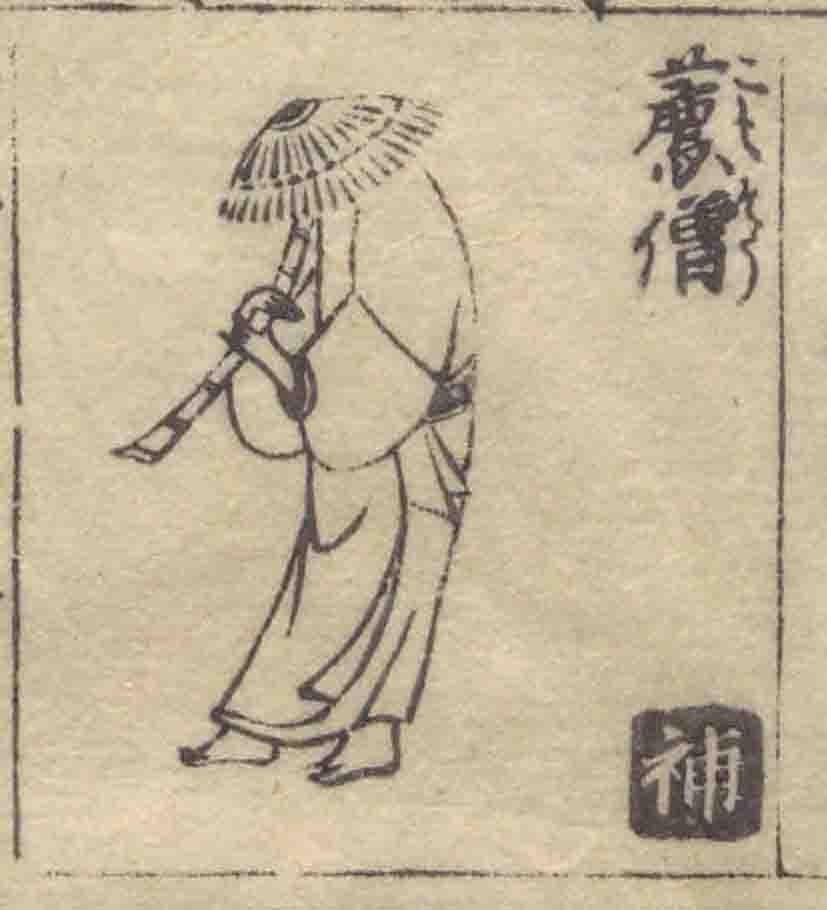Front Page / Index File
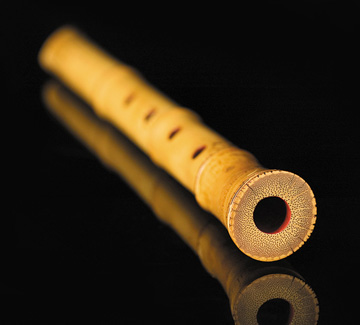
1.8 Myōan shakuhachi by Ozawa Seizan, 1970s
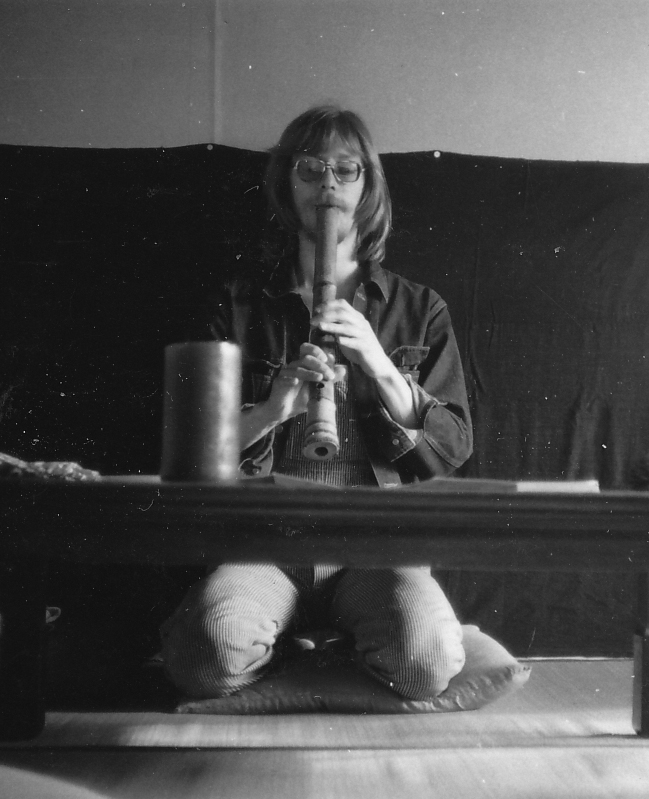
Kyōto, Japan, Spring 1978.
Photo: Walther Ulrich.
T.O. Profile / Bio / CV
Profile Status Update, Late 2022. Original Profile
submitted to Hōgaku Journal Vol. 430, Nov., 2022
T.O.'s Profile at www.komuso.com
Literature in Eastern Languages
Literature in Western Languages
Contact Info
Disclaimer
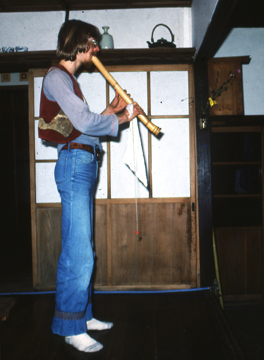
Ichijō-ji, Sakyō-ku, Kyōto, 1977
薦僧/菰僧 - 虚無僧
From 'KOMOSŌ' to 'KOMUSŌ': 1614 to 1664
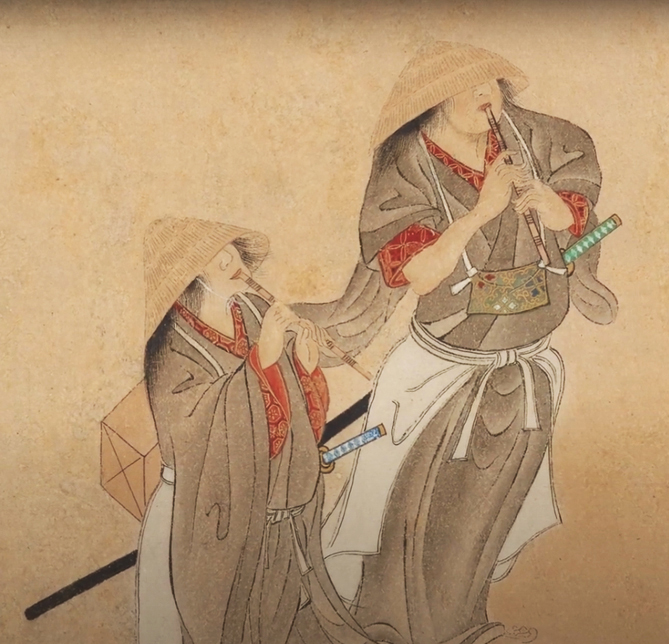
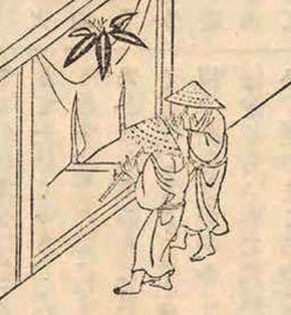
Mid-1620s - Early 1660s
1549 ... The Catholic Christian Century in Japan
& the Temple Patron Household System
1614 to 1664: From 'Ko-MO-sō' to 'Ko-MU-sō'
When That Actually Happened - The Broader Context
Essential Documentary Evidence Observed
1614: The Keichō kenmon-shū Short Story Book:
The 'Fuke-Komosō' in Hachiōji, West of Edo City
1621-1625: Neo-Confucian Scholar Hayashi Razan's Writings
on 'Shakuhachi', 'Komosō', and Related Matters
1623: The "Fuke Monk" at Yūfuku Temple in Tōgō,
mod. Aichi Prefecture
1628: The Kaidō honsoku Fuke-komosō Credo Version 1
1640-1658: Methods of the Christian Convert Inquisition
Described by Inoue Masashige in the Kirishito-ki
1646 at the latest: Abbot Isshi Bunshu's Letter to
"a Proto-Komusō" named Sandō Mugetsu
1664: The Shichiku shoshinshū Music Treatise
by Nakamura Sōsan. The First 'Komusō'
'Shakuhachi-Rōnin' Ever Witnessed in Kyōto?
SPECIAL RESEARCH MATTERS & ISSUES
The Ethnomusicologists' Shakuhachi Historical Facts
Ethical Challenge and Dilemma
- In the Words of SOAS PhD Dr. Kiku Day
1887-1944: Nakatsuka Chikuzen in Memoriam, 2024
A Shakuhachi History Research Pioneer
80th Anniversary
TEXTS, QUOTATIONS, ILLUSTRATIONS
INDIA, CHINA, JAPAN - and THE WEST
A Chronological Panorama - 12 Reloaded
Web Pages from the Previous Website Version
that were Closed as of February 1, 2024
INDIA - 1 Web Page
CHINA - 2 Web Pages
JAPAN - 8 Web Pages
The WEST - 1 Web Page
Welcome to A 1000s of Years' History Odyssey
- Start Here:
• INDIA: 2600 BCE - 800 CE
THE MANY DIFFERENT 'SHAKUHACHI' FLUTES
and THEIR DIFFERENT PLAYERS
Historical Shakuhachi Images Part 1 - till around 1640:
A Pictorial Chronology of Known Fine Historical
Illustrations of so called 'Shakuhachi' Flutes,
Its Many Players Throughout The Times,
with Additional Shakuhachi History Related Images
Historical Shakuhachi Images 2
- from just before 1640 till the Present:
A Pictorial Chronology of Known Fine Historical
Illustrations of so called 'Shakuhachi' Flutes,
Its Many Players Throughout The Times,
with Additional Shakuhachi History Related Images
EXAMPLES of SHAKUHACHI HISTORY
"MYTHS" & "LEGENDS"? MADE UP MISINFORMATION? ...
- FABRICATIONS, FALSIFICATIONS - "FORGERIES"? ...
- DELIBERATE "MISINTERPRETATION"? ...
- WILLFUL "MISREPRESENTATION"? ...
- "INVENTED TRADITION"? or BLATANT LIES? ...
- CONSPIRATORY EXCLUSION of FACTS? ...
- JUST SHEER INCOMPETENCE, and IGNORANCE? ...
- and, EVEN POSSIBLE DELIBERATE HISTORY FRAUD?
1832 ... : Shakuhachi & Komusō "History" Narratives
Written and Publicized in Western Languages
The "BIG LIE": "Nothing like a 'Fuke-shū' ever existed"
1974: 'Komusō' & 'Suizen'?: The Emperor's New Clothes!
PART 1
What Prof. Kamisangō Yūkō Once Precisely Told Us
about Supposed "Edo Period 'Komusō Suizen' Life"
1974: 'Komusō' & 'Suizen'?: The Emperor's New Clothes!
PART 2
What Prof. Kamisangō Yūkō Once Precisely Told Us
about Supposed "Edo Period 'Komusō Suizen' Life"
1974: The Year of the End of 'Shakuhachi Suizen'
- When the Term 'Suizen' was Kidnapped, Hi-jacked,
and Degraded into Mere "New Age", "Healing",
"Holism", and "Mindfulness" Meaninglessness
1980s: Questionable Western Writings about 'Suizen'
Andreas B. Gutzwiller, Christopher Blasdel, Riley Kelly Lee ...
1974 ...: Untruthful 'Suizen' & "Shakuhachi Meditation"
Information & Assertions, East & West
- Presented in Western Languages, Primarily
More "Fuke Shakuhachi" and 'Suizen'
Disinformation in Print and on the Internet,
Discovered & Revealed - Debunked & Rejected
Hottō Kokushi a.k.a. Kakushin Did Not "Invent" 'Suizen',
Nor Did He "Invent" 'Suishō-zen'!
TO BE, OR NOT TO BE: A "ZEN BUDDHIST PRIEST"?
To be - or not to be: a "Zen Buddhist Priest"?
Clarifications by Shakuhachi Player and Researcher
Makihara Ichiro and others
No, No, & No Again:
Edo Period 'Komusō' were not "Zen Monks"
of the Rinzai Zen Sect of Japanese Buddhism:
The 'Komusō' and the Authoritarian 'Danka' System
The 'Komusō' Movement's Place & Destiny
in Mid- to Late Tokugawa Society
楽阿弥 - 両頭切断
Late 15th Century?: The 'Kyōgen' Play 'Rakuami'
and the Shakuhachi "Cutting Away" of Dualistic Thinking
切支丹教世紀
1549 ... The Catholic Christian Century in Japan
& the Temple Patron Household System
1614 to 1664: From 'Ko-MO-sō' to 'Ko-MU-sō'
- When That Actually Happened - The Broader Context
- Essential Documentary Evidence Observed
1628: The Kaidō honsoku Fuke-komosō Credo Version 1
Early 1640s?: The Kaidō honsoku "Version 2"
Copy
Late 1640s?: The Kaidō honsoku "Version 3" Copy
一絲和尚から山堂無月へ
1646 at the latest: Abbot Isshi Bunshu's Letter to
"a Proto-Komusō" named Sandō Mugetsu
1640-1646: Abbot Isshi Bunshu's Letter to Sandō Mugetsu
- the 1981 Kowata Suigetsu Version of the Text
1640-1646: The Hottō Kokushi/Kakushin
Fully Fabricated Fable: The "Four Buddhist Laymen"
& the "Disciple" 'Kichiku'
1665-1675?: The Kyotaku denki Fairy Tale is Born?
Shinchi Kakushin, Kichiku, Kyochiku & Kyōto Myōan-ji
After ca. 1665? to 1795: The Kyotaku denki Original Text,
1981 edition, the Kyotaku denki kokujikai Illustrations,
and Tsuge Gen'ichi's 1977 Translation
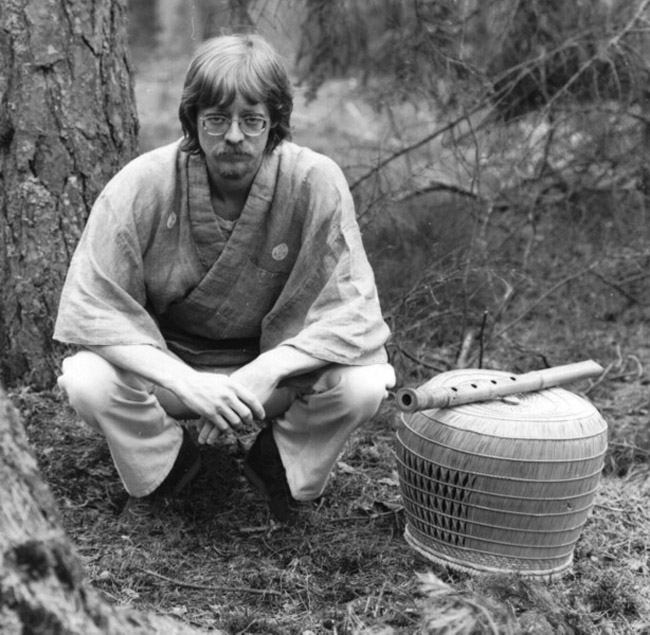
North Sealand, Denmark, 1983
Photo: Mikkel Scharff
- 明暗双双 - 両頭切断
- 不生不滅
ASPECTS of SHAKUHACHI NON-DUALISM:
'MYŌ-AN SŌ-SŌ', 'RYŌ-TŌ SETSU-DAN', 'FU-SHŌ FU-METSU' ...
"Dual(istic) Bright-Dark Pair", "Cutting Off Dualism",
- "Non-Born, Non-Perished"
A forthcoming web page under preparation.
- 無生の曲 - 無常心
- 無弦琴 - 無孔笛
ASPECTS of 'MU' - NOTHING THERE, NONENESS:
MU-SHŌ no KYOKU - MU-JŌ-SHIN
- MU-GEN-KIN - MU-KU-TEKI
"Music of the Non-Born", "Mind of Impermanence"
- "Zither with no Strings", "Flute with no Holes"
A forthcoming web page under preparation.
- 行脚 - 物乞い - 托鉢
- 行 - 修行
- 気息修行 - 吹笛修行
- 吹簫禅 - 吹禅
- 行の音楽 - 尺八修養
ASPECTS of ASCETIC SHAKUHACHI PRACTICE:
- ANGYA - MONOKOI - TAKU-HATSU
- GYŌ - SHU-GYŌ
- KISOKU SHUGYŌ - SUI-TEKI SHU-GYŌ
- SUI-SHŌ-ZEN - SUI-ZEN
- GYŌ no ONGAKU - SHAKUHACHI SHŪ-YŌ
Chronology of Ascetic Shakuhachi
Ideology-related Terms, Concepts & Names
Ascetic Shakuhachi Ideology: Documentation
of the Experienced Basically Non-Dual Nature
of Ultimate Reality - Highlighted Quotations
1930: Kobayashi Shizan & Tomimori Kyozan
Co-publicize the Shakuhachi Concept 'Suishō-zen' a.o.
1950s ... : The Origin of 'Suizen' at Kyōto Myōan-ji:
Kobayashi Shizan, Tomimori Kyozan,
Tanikita Muchiku, Yasuda Tenzan,
Hirazumi Taizan, Koizumi Ryōan,
Fukumoto Kyoan, Yoshimura Sōshin a.o.
1960: Uramoto Setchō's Statement about
'Gyō no ongaku': "Ascetic Music"
1977 & 1978: The Legacy of the Late Myōan Taizan-ha
'Suizen' Players/Teachers Yoshimura 'Fuan' Sōshin
& Ozawa 'Zetsugai' Seizan - and Hisamatsu Fūyō's
Sincere Ascetic Shakuhachi Credo 200 Years Ago
1995: This is Original 'Suizen' Shakuhachi, Myōan Taizan-ha
Tradition: Yoshimura Fuan Sōshin
'Suizen ichinyo', 1995 - An Utterly Ignored,
If not Even Deliberately "Purged", Yet Monumental
Myōan Taizan-ha 'Suizen' Shakuhachi Sound Collection
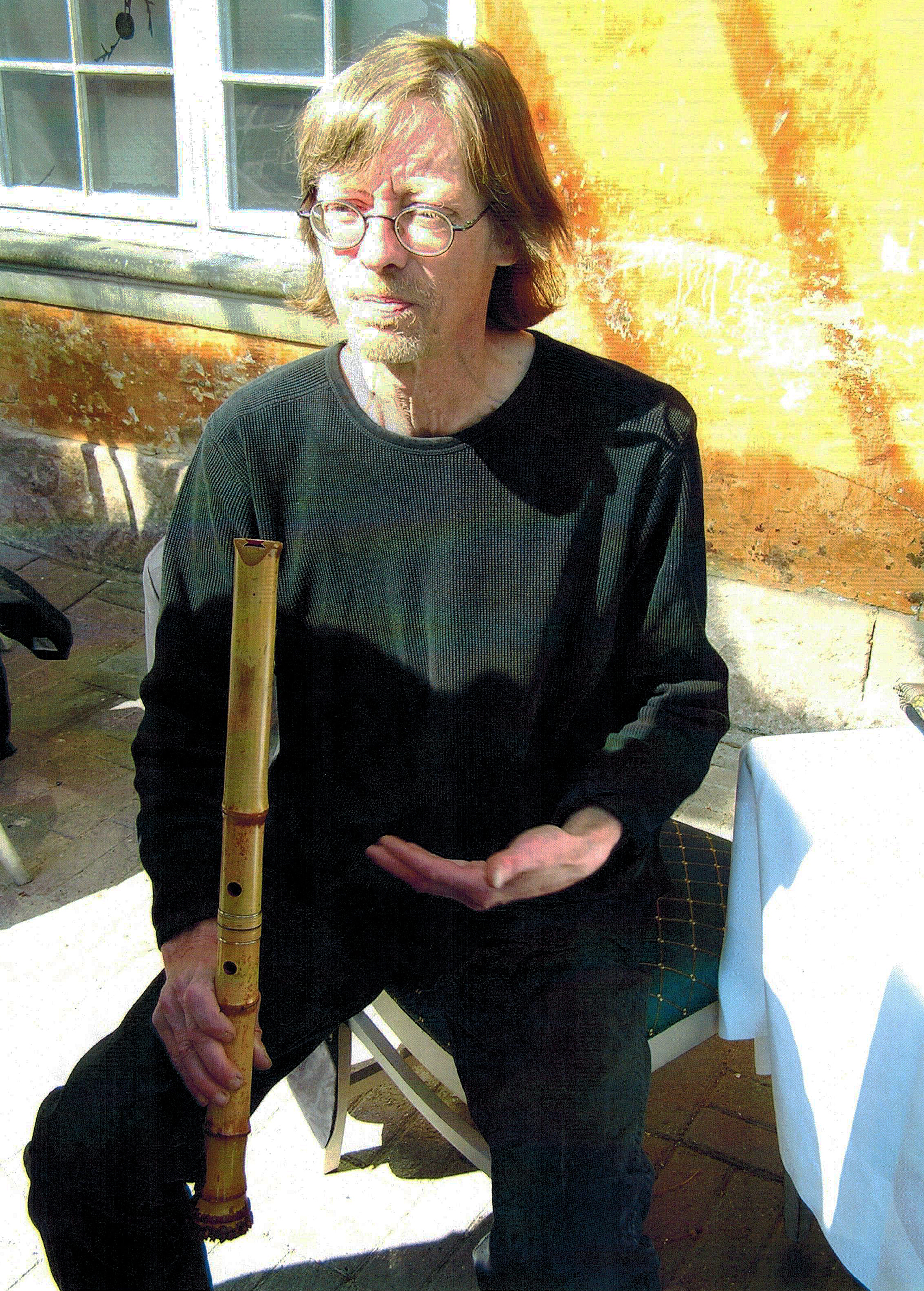
Copenhagen, 2009
Photo by Elisabeth Grønvald
SPECIALLY SUGGESTED READINGS & LINKS
- Books, Articles and Youtube Videos:
C.R. Boxer: "The Christian Century in Japan." Important
1967 publication now also available as PDF file
The Shimabara Rebellion
The 'Shūmon aratame' Sects Inquisition Bureau."
Edward Hagemann:
"The Persecution of the Christians in Japan
in the Middle of the Seventeenth Century." PDF file
Namlin Hur: "Anti-Christianity and Funerary Buddhism
in Tokugawa Japan." PDF file.
Kenneth A. Marcure: "The Danka System." PDF file
Tamamuro Fumio & Duncan Williams: "The Development
of the Temple-Parishioner System." PDF file.
Matt Gillan: "Sankyoku Magazine and the Invention
of the Shakuhachi as Religious Instrument
in Early 20th-Century Japan." PDF File
2019-2023:
Zen-Shakuhachi.dk Research Inspired Youtube Videos
by Shawn Renzoh Head and Nick Hoko Bellando
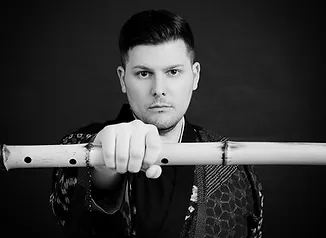
Shawn Renzoh Head.
Photo source: shawnheadmusic.com, 2024
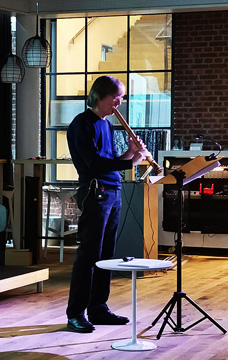
North Sealand, February, 2019
The final (?) 'Suizen' lecture at Elsinore Library
TEXTS, QUOTATIONS, ILLUSTRATIONS
A Chronological Panorama - 12 Reloaded
Web Pages from the Previous Website Version
INDIA - 1 Web Page:
• INDIA: 2600 BCE - 800 CE
CHINA - 2 Web Pages:
• CHINA 1: 6000 BCE - 500 CE
• CHINA 2: 500 CE ...
JAPAN - 8 Web Pages:
• JAPAN 1: 600 - 1233
• JAPAN 2: 1233 - 1477
• JAPAN 3: 1477 - 1560
• JAPAN 4: 1560 - 1614
• JAPAN 5: 1614 - 1664
• JAPAN 6: 1664 - 1767
• JAPAN 7: 1767 - 1883
• JAPAN 8: 1883 ...
The WEST - 1 Web Page:
• The WEST: 1288 ...
|
|
WELCOME ☺
INTRODUCTION
Unveiling & Verifying the Actual Historical Origins & Unique Secrets
of Ascetic, Non-Dualistic Shakuhachi Traditions, Ideologies & Practices
Introduction & Guide to the Documentation & Critical Study of Ascetic,
Non-Dualistic Shakuhachi Culture, East & West:
Historical Chronology, Philology, Linguistics, Terminology, Etymology, Vocabulary,
Concepts, Semantics, Ideology & Iconology
By Danish/Icelandic Torsten Olafsson, Denmark: Multi Musician, Composer, Lyrics Writer,
Music Publishing Editor, Graphical Designer, Photographer, Web Designer,
Japanologist, Chronologist, Shakuhachi Historian, Translator, Author & Lecturer
From the beginning, active WWW Internet presence since 2003:
An unbiased, non-profit, strictly documentary evidence based research and information endeavour
completely independent of any external funding,
totally devoid of self-promoting academic career aspirations and any possible implicated imagined financial profit prospects ...
Torsten Olafsson's 1987 master's thesis in Japanology titled
"Early Seventeenth Century Shakuhachi Ideology.
THE KAIDŌ HONSOKU:
A Komosō's Fuke Shakuhachi Credo Dated 1628.
University of Copenhagen, Denmark, 1987."
was published internationally in 2003 by Tai Hei Shakuhachi, c/o Monty H. Levenson, Willits, California.
Academic, truth-seeking credo:
Only objective, unprejudiced, well documented evidential historical facts count and matter ...
- secondarily so, though - maybe just at times - objective and unbiased
educated academic speculation may occasionally be allowed for,
under due responsibility, of course.

Kronborg, Elsinore, North Sealand, a.k.a. "Hamlet's Castle". Photo: Torsten Olafsson
I Have a Fascinating and Important 'Shakuhachi' Story to Tell You.
And: I Am Not Lying to You
Kind Regards, Torsten Olafsson, Denmark, July 4th, 2024
Origin of the 'Komusō'?
Had There Not Been an Invasion of Christian Catholic Missionaries Since 1549,
and Those Hundreds of Thousands of Their Fanatically Devoted Japanese Christian Converts
in Early 17th Century Deeply Xenophobic Japan,
There Would Never Have Existed a Single 'Komusō' on the Isles of Japan:
No Distorting Falsification of History; No Long, Thick "Root-end" Bamboo Flutes ...
No Invented "Fuke Temples" & "Fuke Sect" - No 'Fuke Shakuhachi' ...
No Socalled 'Honkyoku' "Music" Pieces - No 'Hōki' - No "Shakuhachi Zen" ...
No Socalled 'Suizen'!
That is the Story to be Told and Clarified Here.
Four Historical Shakuhachi Pictures That You Should Not Trust in
as Reliable Documentary Evidence of 'Komo-sō' and Komu-sō' Reality
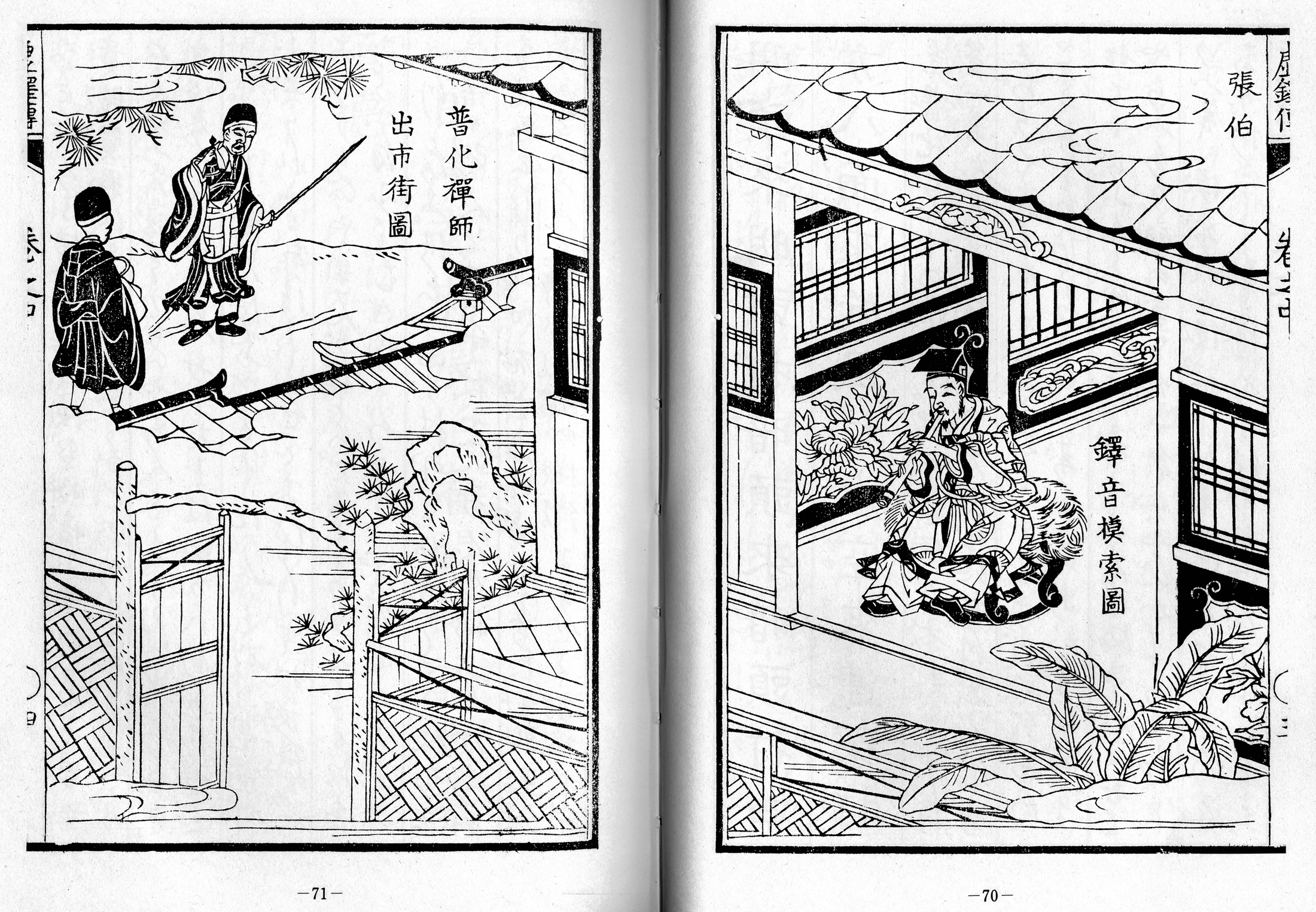
1795, Kyotaku denki kokujikai: Early 9th century Fuke, ringing his bell, and alleged
'Kyorei' composer, Chōhaku, with his supposed "Chinese shakuhachi".
How come that the illustrations shows a typical late 18th century root-end 'shakuhachi',
not some original 9th century Chinese vertical flute with 6 fingerholes?
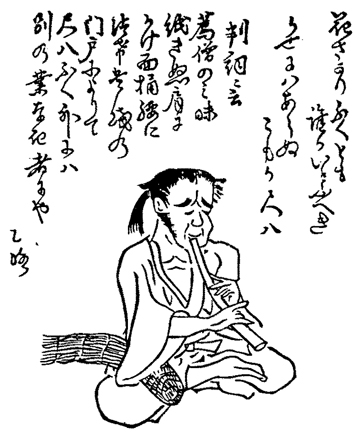

Left:1799: Incorrectly and misleadingly executed rendering of a supposed 15th century 'Komosō'
"mat monk", by Ban Kōkei, in his book 'Kanden kōhitsu'.
Right: 13th century?: Extremely incorrectly dated copy of an actual early 1660s 'Komusō'
illustration seriously misleadingly published by Wong Wah-sang in a 2014 article of his.
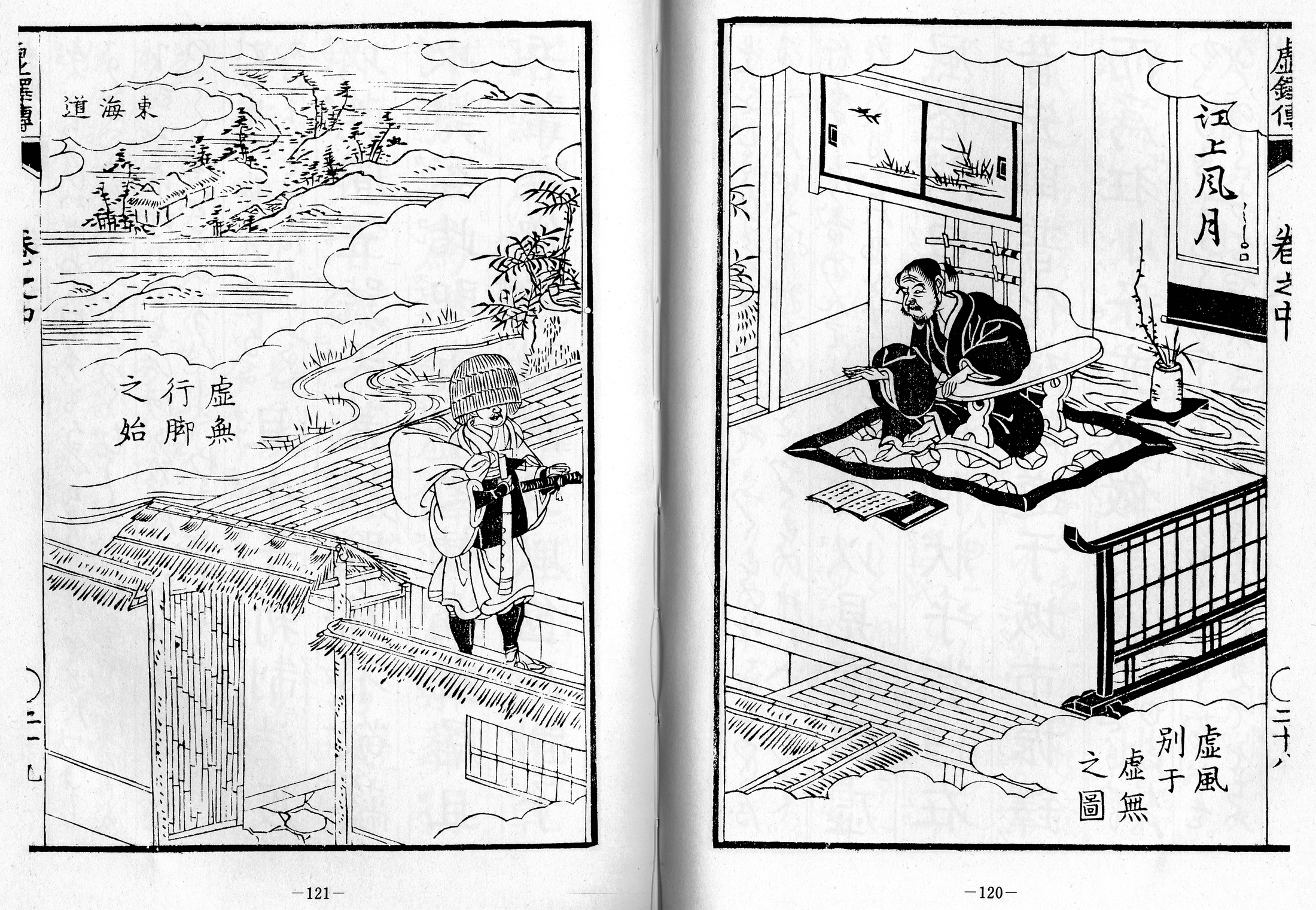
1795, Kyotaku denki kokujikai: Completely out of proper chronological context 'Komusō' picture.
Left: Fabricated 14th century 'Kyomu' figure however pictured
as a late 18th century 'Komusō' mendicant.
Right: 'Kyōfū', another of 'Kyotaku denki kokujikai's
completely fabricated, non-historical persons.
"The Persecution of the Catholic Christians in Japan
During the Middle Years of the Seventeenth Century."
穴吊るし
ANA-TSURUSHI - "Hole Hanging"
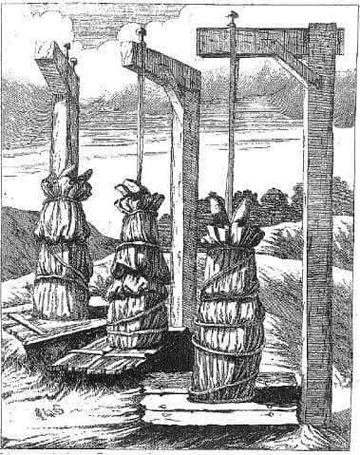
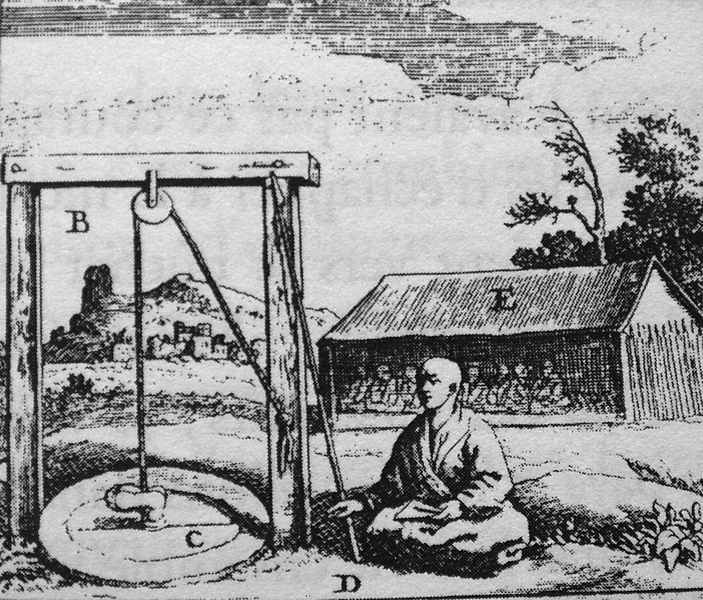
The 'ana-tsurushi' method of inquisitioning and torturing stubborn and resisting Japanese Christian converts,
intensifying in the 1630s and 1640s
Image sources: Facebook and Wikipedia
Quoted from the opening section of a 1942 article by Edward Hagemann:
“About three hundred years ago, in 1640, Japan took the last and most effectual step to eradicate all Western influence from her people.
The year before, 1639, the last definite decree had been enforced forbidding all commercial intercourse to the Portuguese.
By this means all further contact with the Western world had been stopped, and no more Christian missionaries could be sent to Japan.
But in Japan itself, despite the ban on Christianity, there were still some hundreds of thousands of Christians.
These had to be exterminated, and everything that savored of foreign influence removed.
In 1640 the office of the inquisition was erected to carry out this policy.”
Source:
Edward Hagemann: "The Persecution of the Christians in Japan
in the Middle of the Seventeenth Century."
Publ. in Pacific Historical Review
Vol. 11, No. 2, June, 1942, pp. 151-160 (10 pages)
Made available byy: University of California Press
Link to online PDF file: https://www.jstor.org/stable/3633765
Excerpt from a book review by K.S. Latourette, 1941:
" - - - The attempt of the Tokugawa to rid the realm of the obnoxious foreign faith led not merely to drastic measures which drove Christianity underground,
but was the major cause as well for the prolonged segregation of the empire from intercourse from the West except for the limited trade through the Dutch at Deshima. - - - "
The book reviewed:
Gustav Voss & Hubert Cieslik (trsls.): Kirishito-ki und Sayo-yoroku:
Japanische Dokumente zur Missionsgeschichte
des 17. Jahrhunderts (English).
Sophia University, Tokyo, 1940, 229 pages.
Link to the review:
https://www.cambridge.org/core/journals/journal-of-asian-studies/article/abs/kirishitoki-und-sayoyoroku-japanische-dokumente-zur-missionsgeschichte-des-17-jahrhunderts-by-gustav-voss-and-hubert-cieslik-tr-tokyo-sophia-university-1940-viii-229-p-275-750/F61F3E46BED9A5D2116C89A6210A307E
1614 to 1664: From 'Ko-MO-sō' to 'Ko-MU-sō'
薦僧/菰僧 - 虚無僧
1614 to 1664: From 'Ko-MO-sō' to 'Ko-MU-sō' - When That Actually Happened
The Broader Context - Essential Documentary Evidence Observed & Recognized
The very last sincerely practicing pseudo Buddhistic 'Fuke Komo-sō' expressed themselves utterly comprehensively
in a unique 'shakuhachi rōnin' credo dated 1628, the Kaidō honsoku.
The very first credibly recorded and named, also pseudo Buddhistic 'shakuhachi rōnin' 'Komu-sō', ever was so addressed only just after 1640, and not later than 1646.
His name was given as 'Sandō Mugetsu', in a letter composed by distinguished Rinzai Zen abbot and artist Isshi Bunshu, 1608-1646.
Whatever else you are being told, over and over, and yet again? Ignore it!
Chronology of Texts, Quotations, and Illustrations
India, China, Japan, and the West - 2004 to 2024
When, now 20 years ago, in 2004, the present website project was first launched online,
the skeleton that it was build on was a timeline, a chronology for ascetic shakuhachi history related facts, events,
and references to be added and presented, as they materialized during the many years of ongoing research.
Editing and reworking the original 12 web pages, they have now been reloaded with new file names.
There are likely still to be links to external internet web places that do no longer work anymore, after so many years.
That's the reality on today's internet.
Countless Shakuhachi Players & Fantasy "History" Tellers
Are Still Lying to You, Non-stop. Period.
The Kyotaku denki Debunked, Again, Again - and Again!
This declaration will be updated continuously. Torsten Olafsson, June 25, 2024.
No – Early 9th century Buddhist monk Fuke Zenji never inspired any Chinese flute player to create any melody imitating his beggar’s bell. Period.
No – Neither, of course, was Fuke Zenji a "shakuhachi teacher", himself. Period.
No – The invented "tune", later referred to as 'Kyorei', never survived for twelve generations till the mid-13th century. Period.
No - Shinchi Kakushin, a.k.a. Hottō Kokushi, never learned 'Kyorei' during his Zen studies in China. Period.
No – Shinchi Kakushin is never ever reported to have played any type of 'shakuhachi'. Period.
No – 'Shi-koji', "Four Buddhist Laymen", never accompanied Kakushin on his return to Japan in 1354. Period.
No – Never existed "Four Buddhist Laymen" ever had any followers. Period.
No – Shinchi Kakushin never had a devoted Japanese disciple named 'Kichiku'. Period.
No – Shinchi Kakushin never "established" 'Sui-shō-zen' nor 'Sui-zen' practices
in the 13th century. Period.
No - Never existed 'Kichiku' ever composed neither 'Mukaiji' nor 'Kokū'. Period.
No – Never existed "disciple" 'Kichiku' ever had any disciples, no followers. Period.
No – None of Kakushin or Kichiku’s never existed "disciples" ever founded the Myōan Temple in Kyōto. Period.
No – The samurai leader Kusunoki Masakatsu was definitely not Japan’s first 'Komusō'. Period.
No – 'Kichiku' - who "miraculously" turned 'Kyochiku Ryōen Zenji' - did not found the Kyōto Myōan Temple. Period.
Besides: No - Historical 'Komusō' are nowhere at all reported to have practiced any form of "shakuhachi meditation".
No - 'Suizen' was not practiced by historical 'Komusō', whatsoever.
Full stop!
NEWS BOARD - EARLY JUNE 2024
New Translation by Shawn Renzoh Head: "THE TRUE KOMUSO"
"Historical Truth" - According to Edgard W. Pope, 2000:
" ... the business of historians is to construct
the truest versions [of history] possible."
"The existence of different versions of history, then, does not show that all versions are
equally valid, or equally biased. What it shows is that there is an ongoing tension between
historical evidence and the biases of historians, and that the writing of history requires a
constant effort to set aside one's biases when looking at the evidence.
While "absolute" historical truth may be an unattainable (indeed indefinable) ideal, it is clear that some versions
of history are more true than others, and that the business of historians is to construct the truest versions possible."
Quoted from:
Edgar W. Pope: "The Shakuhachi, the Fuke-shū, and the Scholars : a historical controversy."
In: Journal of Hokusei Gakuen Women's Junior College 36, 31-44,
Hokusei Gakuen University, Sapporo, 2000.
Link:
"The Shakuhachi, the Fuke-shū, and the Scholars : a historical controversy"
Hottō Kokushi a.k.a. Kakushin Did Not "Invent" 'Suizen',
Nor Did He "Invent" 'Suishō-zen!
Overall Conclusion that has Manifested Itself
as a Result of the Present now 50+ Year Long Lasting Research Endeavour
The asserted history and alleged characteristics of Ascetic Shakuhachi Practices in Japan have been most purposefully constructed,
fabricated, falsified, ever since the earliest beginnings.
This constantly ongoing activity of deliberate source falsification, forging and fanciful "history" fabrication is taking place still,
this very day - generated by "professionals" and "amateurs" alike,
inside as well as outside of Japan - be they both shakuhachi musicians and players, musicologists, "history" writers, ethnomusicologists,
book editors and publishers - besides a wide variety of enough so sincerely devoted shakuhachi "admirers", generally speaking.
Very little indeed of what you can find and read in most of the books and articles, in phonogram cover notes
and on the internet - be that on websites or weblogs presented in a variety of languages -
can actually be soberly corroborated when first one is investigating the totality of known preserved text and picture source materials
- the multitude, comprehensiveness and complexity, inapproachability and degree of difficulty of which
is not only aweinspiring but verily terrifying.
Carried by and on the Internet, especially, lies and untruths have been spreading like wildfire over the last 10 to 20 years,
in particukar, and even more increasingly so.
In words attributed to Mark Twain a.o., paraphrasing the Roman poet-philosopher Virgil (Publius Vergilius Maro)
who lived about 2.000 years ago, and many others since then:
"A Lie Is Halfway Round the World Before the Truth Has Got Its Boots On."
Virgil's original saying: "Fama, malum qua non aliud velocius ullum."
In Book IV of the Aeneid, a worldfamous Roman work in Latin created between 19 BCE and 29 CE.
Suggested link: https://interestingliterature.com/2021/06/lie-halfway-round-world-before-truth-boots-on-quote-origin-meaning/#
The Financial Times' "loose" translation: "Rumour — no other evil travels more quickly."
Link: https://www.ft.com/content/52770ebe-2393-11e8-add1-0e8958b189ea
Re-edited, expanded and reposted statement -
Torsten Olafsson, Elsinore, Denmark, February 29, 2024
'Shakuhachi Rōnin', 'Komosō', 'Fumi-e' - and 'Komusō' "life" only after 1640
尺八浪人 - 薦僧 - 踏み絵 - 虚無僧
Shakuhachi playing masterless samurai, then 'shakuhachi-rōnin' 'komosō' mat monks,
the trambling on a Christian image to reject Christianity,
and the very first "Pseudo-monks of the Non-Dual & None-ness" in mid-1600s century Japan.
Like all other Japanese natives without exception, beginning in 1629 shakuhachi-playing 'Fuke'komosō',
masterless 'rōnin' samurai, had to confirm every year that they were not Christian converts in hiding.
All Japanese were not only "required", but forced, to be registered members of one particular established Japanese Buddhist sect.
That is the subject of yet a new more intensified, ongoing research, fact-finding and information endeavour.
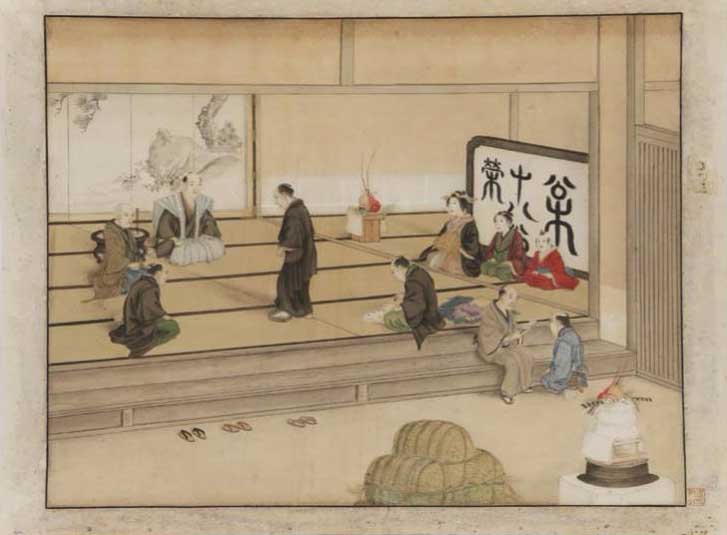
Painting of a 'fumi-e' inquisitional ceremony by Keiga Kawahara, 1786–1860?, a citizen of Nagasaki,
created sometime around 1826.
Source: National Library of the Netherlands.
"Shakuhachi Zen" & "Zen Shakuhachi"?
- These Expressions are Quite Simply Only Western Post-WW2 Inventions!
禅
と
尺八
:
関係
が
全然無
い。
'Zen to shakuhachi: Kankei ga zenzen nai!'
- "Zen and Shakuhachi?: There Is No Connection at All!"
- Yoshida Mitsukuni, 1921-1991.
Former professor at Kyōto University, Japan: Dept. of Japanese Arts & Aesthetics.
Private conversation, Kyōto, March, 1977.
'Zen' & "Shakuhachi" - and 'Suizen' - acc. to Bob Berlin-Grous & Monty H. Levenson, 2019:
"If viewed only in terms of the political, sociological, and even musical history,
the connection between shakuhachi and Zen may indeed seem rather superficial.”
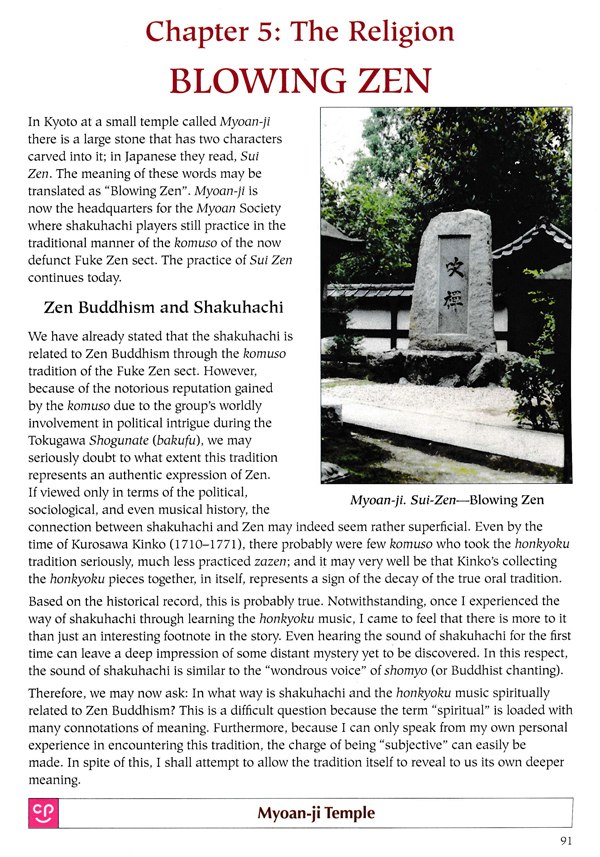
Source: Bob Berlin-Grous & Monty H. Levenson:
The Sound of Bamboo: Blowing Zen & The Spirit of Shakuhachi.
Tai Hei shakuhachi, Willits, CA, USA, 2019.
'Zen' & "Shakuhachi Meditation" – and 'Suizen' - acc. to Oliver Aumann, Japanologist & Itchōken Tradition player:
“There are no traditional texts in the Fuke-sect that would systematically explain how to meditate.”
“The term seems to be relatively modern, but has become a kind of motto for the modern Komusō.”
“In many cases suizen refers to nothing more than a ceremonial playing within a temple, with certain strict formalities.”
Source: Former Oliver Aumann 'Komusō'/Shakuhachi website, last visited in 2021.
Original URL/link to web page, now apparently closed:
On "Meditation"
“For the historical Komusō, a substantive relationship with the Zen school is scarcely verifiable, and for the modern Komusō,
the term "Zen-Buddhist" is simply inaccurate."
Source: Former Oliver Aumann 'Komusō'/Shakuhachi website, last visited in 2021.
Original URL/link to web page, now apparently closed:
On "Zen Shakuhachi"
'Zen' & "Shakuhachi" - and 'Suizen' - acc. to Christian T. Mau, PhD, 2014:
- - - “Thus, suizen, very fundamentally means blowing (the shakuhachi) meditation."
"As an activity and concept, it is not only inextricably linked to the shakuhachi in general, but especially to Myōan Temple,
as the large stone marker on the grounds bears testimony to.”
"As surprising as it may sound to those already familiar with the expression, however, the word's coinage is less than a century old,
thus often rendering its usage somewhat anachronistic when applying it in connection with pre-20th century practice."
“Thus it is frequently used indiscriminately — apparently without knowledge of its origins” — leading De Ferranti, as one example,
to report that "[b]y the seventeenth century the Fuke sect of Zen had institutionalized the practice of suizen.
(De Ferranti 2000:71; see also Kamisangō 1988:97,125; Lee 1998:149–150)."
“The problem here is that, while the manner of using the shakuhachi may well have been institutionalised and identified with the Komusō of the Fuke sect,
there certainly does not seem to have been a dedicated term applied to the instrument's usage in this context."
Source: Christian T. Mau PhD thesis, 2014, p. 115.
Link:
Christian T. Mau 2014 SOAS thesis, PDF file
1977 & 1978: The Legacy of the Late Myōan Taizan-ha
'Suizen' Players/Teachers Yoshimura 'Fuan' Sōshin
& Ozawa 'Zetsugai' Seizan - and Hisamatsu Fūyō's
Sincere Ascetic Shakuhachi Credo 200 Years Ago
禅尺八 - 吹禅 - 'ZEN SHAKUHACHI' & 'SUIZEN'
修養の尺八 - 'SHŪYŌ no SHAKUHACHI'
"The Shakuhachi of Self-cultivation/Self-discipline/Mental Training"
The Myōan Taizan-ha Way of Authentic Shakuhachi 'Suizen' Asceticism
represented by Yoshimura Fuan Sōshin, 40th 'Kansu' of Kyōto Myōan-ji.
明暗寺四十世 芳村普庵宗心
MYŌAN-JI YONJŪ-SE YOSHIMURA FUAN SŌSHIN
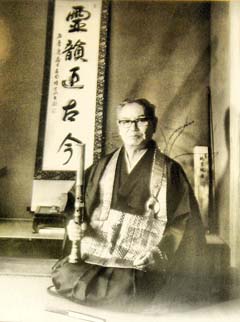
Yoshimura Fuan Sōshin - 1904-1998
1977, August 9 - YOSHIMURA FUAN SŌSHIN:
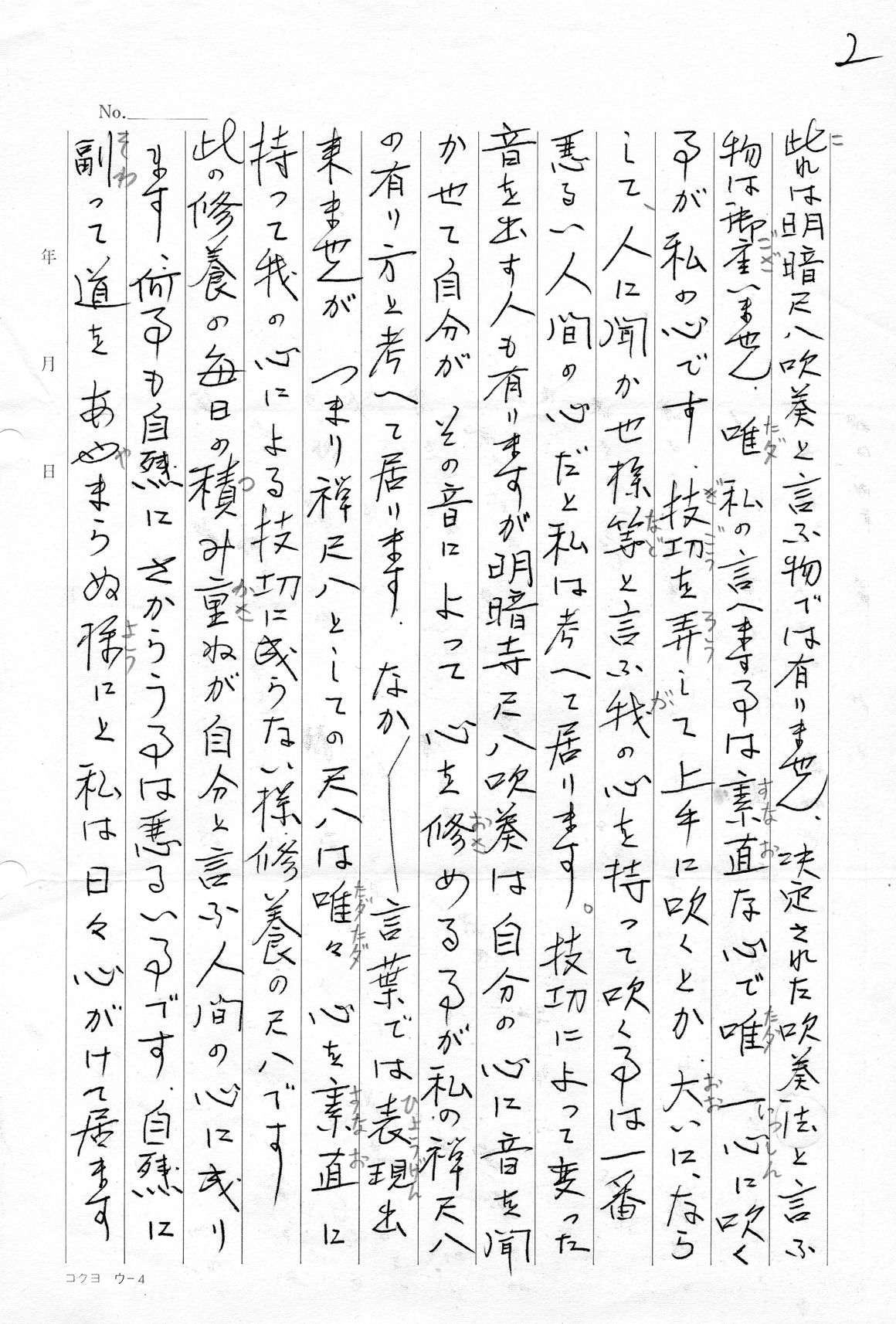
Yoshimura Fuan Sōshin's letter to Torsten Olafsson, August 9, 1977, page 2
此れは明暗尺八吹奏と言ふ物でわ有りません。
決定された吹奏法と言ふ物は御在いません。
唯、私の言えまするは素直な心で、
唯、一心に吹くるが私の心です。
技功を弄して、上手に吹くとか、
大いにならして、人に聞かせ様等
と言ふ我の心を持って吹くるは
一番悪い人間の心だと
私は考えて居ります。
技功によって変わった音を出す人も有りますが、
明暗寺尺八吹奏は自分の心に音を聞かせて
自分がその音によって、心を修めるるが
私の禅尺八の有り方と考えて居ります。
なかなか言葉では表現出来ませんが、
つまり禅尺八としての尺八は唯々
心を素直に持って, 我の心による
技功に成らない様、修養の尺八です。
此の修養の毎日の積み重ねが
自分と言ふ人間の心に成ります。
何るも、自然にさからうるは悪いるです。
自然に副って、道をあやまらぬ様にと
私は日々心がけて居ります。
"Myōan Shakuhachi can not be likened to the playing of an ordinary wind instrument.
Such thing as a fixed way of playing does not exist.
What I can say is, plainly, that I am only concerned with directing my blowing
towards my own Self - with a gentle mind.
It is my opinion that people who trifle with skill of playing and "play well"
- who exercise exceedingly intending to impress the listener and the like -
that way of blowing with an egocentric mind represents the worst of human attitudes (that I can think of).
There are people who produce changing sounds depending on technical skill,
but as for the shakuhachi practice of the Myōan Temple,
I believe that the ideal way of Zen Shakuhachi
is to let one's true Mind listen to the sounds and to cultivate one's own Self
in accordance with those sounds.
I can not easily express this in words but to practice the shakuhachi of 'Zen Shakuhachi' is indeed a way of mental training and self-cultivation that is practiced
with an open and humble mind and does not develop into technical skill with a selfish attitude.
The accumulation of this daily practice will, eventually,
bring about the realization of the true Self of one's Human Nature.
It is, in any case, wrong to act against Nature.
I am devoting myself every day to follow Nature and not to be mistaken about the Way."
Yoshimura Fuan Sōshin, Myōan-ji, August 9, 1977.
Private correspondance. Trsl. by Torsten Olafsson.
Read more about Yoshimura Sōshin at www.komuso.com, link:
https://www.komuso.com/people/people.pl?person=982
明暗尺八 - MYŌAN SHAKUHACHI
明暗雙雙 - MYŌAN SŌSŌ - "The Myōan Pair"
法器 - HŌKI - "Instrument of the Buddhist Law"
小沢絶外盛山
1978 - OZAWA ZETSUGAI SEIZAN
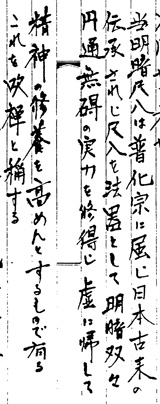
Detail of a letter of recommendation for T.O.
written by Ozawa Seizan in Spring, 1978
See translation below ...
当明暗尺八は、普化宗に属じ日本古耒の伝承されじ
尺八お法器として、明暗双々円通無碍の実力を修得じ、虚に帰して、精神の修養を高めんとするしので有る。
これを吹禅と稱する。
"Myōan Shakuhachi is related to the Fuke Sect of Shakuhachi and it has as its purpose to employ the ancient Japanese shakuhachi flute as a Dharma instrument [hō-ki]
in order that one understands the Ultimately Adual Nature of the 'Bright' and the 'Dark' [Myō-An] and experiences the Essence of Non-substantiality
[kyo] through Self-Cultivation.
This [practice] is called 'Suizen'."
By Ozawa Seizan, 1939-2012, Myōan-ji, 1978, in a letter
of recommendation to the author. Trsl. by Torsten Olafsson.
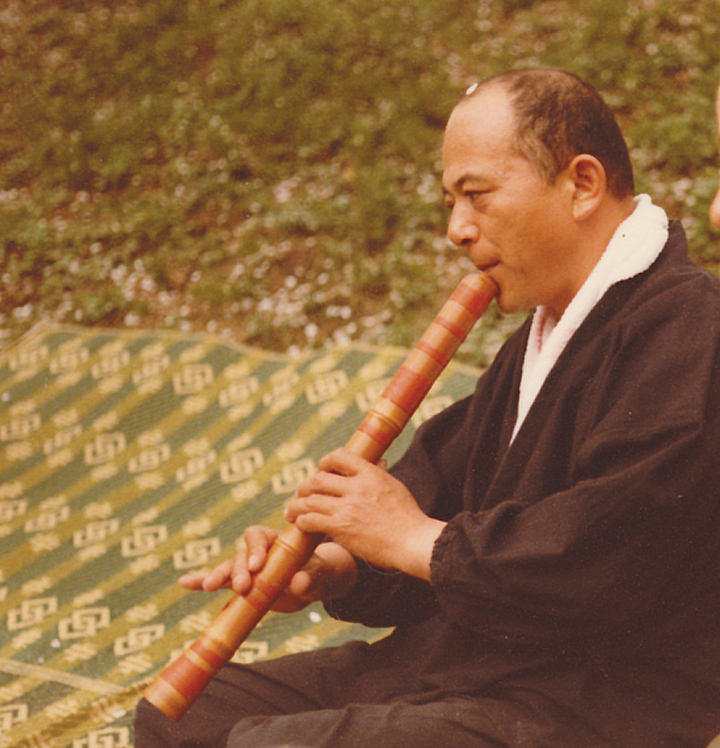
Ozawa Seizan Sensei, 1939-2012
Photo: Torsten Olafsson, Spring, 1978
Read more about Ozawa Sensei at www.komuso.com, link:
https://www.komuso.com/people/people.pl?person=1617
An INTERESTING BACKGROUND PERSPECTIVE:
In a publication dated 1818, titled Hitori-goto,
独言,
Hisamatsu Fūyō, 1791-1871, a renowned representative of the early Kinko-ryū Shakuhachi tradition,
expressed the following:
「初心より美敷音のむまみを修行すべからず、
音艶むまみは出来るを好んで出かすを嫌ふ。」
'Shoshin yori, utsukushiki oto no mumami o shugyō subekarazu.
Ne-en mumami wa dekiru kononde, dekasu o kirau.'
"From the beginning (lit. with a beginner's intention), do not (ascetically) practice
the "tastefulness of a beautiful sound".
I dislike it when people please themselves with putting out tasteful "sound gloss"."
Trsl. by T.O.
That is what Hisamatsu Fūyō expressed in humble writing at the time when the ‘Kinko-ryū’ tradition of shakuhachi asceticism had not yet changed,
metamorphosed, into a sophisticated, technically demanding "shakuhachi 'honkyoku' concert performance art form".
In 1983, Andreas Gutzwiller published this translation in German, in his book "Die Shakuhachi der Kinko-Schule”:
"Man darf nicht von Anfang an danach streben, einen schönen Ton zu erlangen,
und es ist verdammenswert, wenn jemand es liebt, einen glanzvollen Ton hervorzubringen."
Wolfgang Fuyūgen Heßler presented his English translation like this:
"One must not deliberately strive from the beginning to achieve a beautiful tone.
It is disgraceful when someone loves to produce a splendid tone."
Source: http://komuso.ch/?page_id=313&lang=en
And, in 2010/8, Matt Treyvaud contributed with this rendering of his in English:
"As a beginner, do not strive for the (m)umami of beautiful sound.
It is pleasing when polish and (m)umami emerge from (dekiru) the sound;
to force them out (dekasu) is disagreeable."
Source: http://no-sword.jp/blog/2010/08/umami.html
By the way, Matt Treyvaud also cited Hisamatsu-san for this exchange of his
in the 1823 Hitori-mondō,
独問答:
問 普化禅師はいかなる人ぞ
答 知らず禅家の知識に問へ
"Q: What kind of person was Master P'ǔ-huà [Fuke] ?
普化?
A: I don't know. Ask a scholar at a zen temple."
In other words, we should probably surmise that Hisamatsu-san was not himself a Zen monk.
Nor, that he was himself a wandering mendicant 'komusō'.
Editorial note as of February 3, 2024 - Updated on the 6th:
No Field, no Chapter nor Aspect of All Time Recorded World Wide Music "History"
has Ever been More Fabricated, Falsified, Forged, Utterly Distorted
and Misrepresented than that of "the" Japanese 'Shakuhachi' Flute,
the 'Komusō' Pseudo "Monks", and the Fully Fancified Practice
of So Called "Zen Shakuhachi Meditation".
The term, concept and whole idea of 'Suizen',
吹禅,
that was only defined and presented as late as in or soon after 1950 by Kyōto Myōan-ji abbot Yasuda Tenzan,
has now, since 1974,
been reduced and completely distorted to being nothing but a simple banal and meaningless promotional
New Age & Mindfulness business slogan
exploited by countless self declared Western "romantic bamboo flute meditation therapy actors"
- or even academically approved ethnomusicology M.A.s & Ph.D.s, for that matter -
who do not even know how to read neither modern nor classical Japanese texts, including 'kanbun',
and cannot relate to and quote from any of the actual very many existing available documentary evidence sources, at all.
PICTURES on the WEBSITE FRONT PAGE:
1951: "Forget (about) Dualistic Light & Dark Oppositeness" -
- A Calligraphic Statement by Tanikita Rōan Muchiku, 1875-1957
明暗双忘 - MYŌ AN SŌ BŌ
LIGHT DARK PAIR FORGET
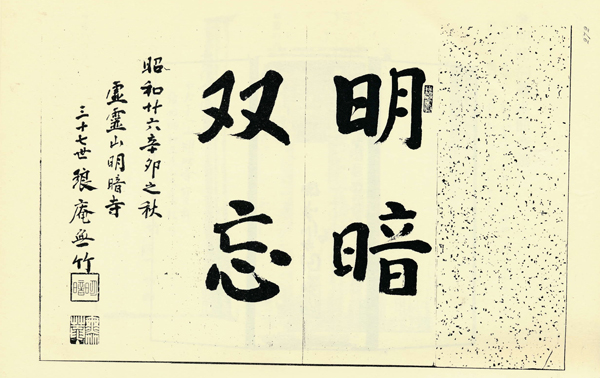
In 1949, Tanikita Muchiku, 1878-1957, was appointed new 'kansu', "guardian", and "37th head",
of the Kyōto Taizan-ha Shakuhachi Tradition at the new,
soon afterwards to be restored Myōan temple in SE Kyōto, in 1950.
This four character calligraphy of his, dated Autumn, 1951, Shōwa 26, 'Aki',
(to the left of the four characters), reads in Japanese,
'Myō An Sō Bō', literally "Light Dark Pair Forget(fulness)".
An interpretive English translation could very well read as this:
"Forget (about) Dualistic Light & Dark Oppositeness".
To the left of the dating you read 'Kyorei-zan Myōan-ji' and 'San-jū-nana-se Rōan Muchiku'.
Source:
Inagaki Ihaku, Izui Seizan & Takahashi Ryochiku, editors:
Myōan sanjūnana-sei Tanikita Muchiku-shū.
Taizan-fu shūi. Tanikita Renzō, Kyoto, 1981.
Interestingly so, on Myōan-ji's official website, Tanikita Muchiku is in fact being presented as
琅庵無竹居士, 'Rōan Muchiku Koji'.
A 'koji' is only a "devoted Buddhist lay practitioner", simple as that.
Not an "abbot", not a "Zen priest" - just a very sincere Buddhist commoner!
Direct link to web page:
Myōan-ji's Traditional Genealogy
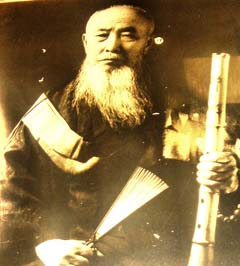
Tanikita Muchiku
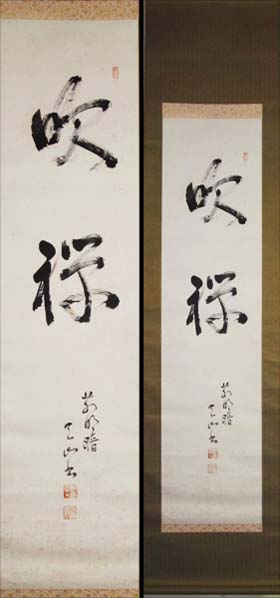
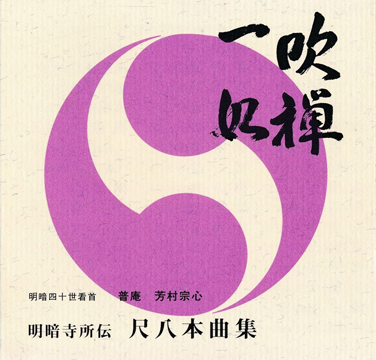
Left: 'Suizen' calligraphy by Yasuda Tenzan, 1950 or very early 1950s
Right: Yoshimura Fuan Sōshin's 'Suizen ichi-nyo' CD front cover, released 1995
'Suizen ichi-nyo' cover calligraphy written by Yasuda Tenzan, n.d.
|
修
行
尺
八
歴
史
的
証
拠
の
研
究
ホ
︱
ム
ペ
ジ
|
